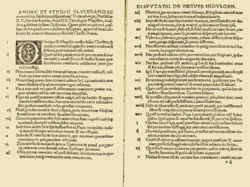This article needs additional citations for verification. (June 2020) |
| Part of a series on |
| Catholic Counter-Reformation |
|---|
 |
| Catholic Reformation and Revival |
| Part of a series on the |
| Reformation |
|---|
 |
| Protestantism |
The Counter-Reformation (Latin: Contrareformatio), also sometimes called the Catholic Revival,[1] was the period of Catholic resurgence that was initiated in response to, and as an alternative to, the Protestant Reformations at the time. It is frequently dated to have begun with the Council of Trent (1545–1563) and to end with the conclusion of the European wars of religion in 1648, though this is controversial.[2] The broader term Catholic Reformation (Latin: Reformatio Catholica) also encompasses reforms and movements within the Church in the periods immediately before Protestantism or Trent and lasting later.
Initiated in part to address the challenges of the Protestant Reformations,[3] the Counter-Reformation was a comprehensive effort arising from the decrees of the Council of Trent. The effort produced apologetic and polemical documents, heresy trials, anti-corruption efforts, spiritual movements, the promotion of new religious orders, and the flourishing of new art and musical styles. Such policies (e.g., by the Imperial Diets of the Holy Roman Empire) had long-lasting effects in European history with exiles of Protestants continuing until the 1781 Patent of Toleration, although smaller expulsions took place in the 19th century.[4]
Such reforms included the foundation of seminaries for the proper training of priests in the spiritual life and the theological traditions of the Church, the reform of religious life by returning orders to their spiritual foundations, and new spiritual movements focusing on the devotional life and a personal relationship with Christ, including the Spanish mystics and the French school of spirituality.[1] It also involved political activities and used the regional Inquisitions.
A primary emphasis of the Counter-Reformation was a mission to reach parts of the world that had been colonized as predominantly Catholic and also try to reconvert nations such as Sweden and England that once were Catholic from the time of the Christianisation of Europe, but had been lost to the Reformation.[1] Various Counter-Reformation theologians focused only on defending doctrinal positions such as the sacraments and pious practices that were attacked by the Protestant reformers,[1] up to the Second Vatican Council in 1962–1965.[5]
- ^ a b c d "Counter-Reformation". Encyclopædia Britannica Online. Archived from the original on 18 November 2008. Retrieved 6 July 2019.
- ^ "Counter-Reformation | Definition, Summary, Outcomes, Jesuits, Facts, & Significance | Britannica". www.britannica.com. Archived from the original on 2008-11-18. Retrieved 2023-01-22.
- ^ Mark, Joshua J. "Counter-Reformation". World History Encyclopedia. Archived from the original on 2023-01-22. Retrieved 2023-01-22.
- ^ Der geschichtliche Ablauf der Auswanderung aus dem Zillertal Archived 2016-05-07 at the Wayback Machine [lit. 'The Historical Chain of Events of the Migration from the Ziller Valley'] (in German), 1837-auswanderer.de. Accessed 13 June 2020.
- ^ "Anniversary Thoughts". America. 7 October 2002. Archived from the original on 19 April 2017. Retrieved 18 April 2017.